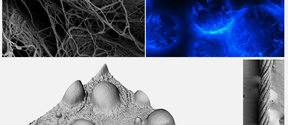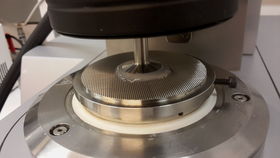Biomolecular Materials Research

Home Research People Publications Gallery
We try to understand and copy how such materials function starting from a molecular level, and show how the structure of molecules and their interactions can lead to different materials properties. Proteins are especially interesting for this because the techniques of modern biology allow a very detailed molecular engineering of their structures.
We also study cellulose as a molecular material and how we make use of molecular interactions and its special mechanical properties to make completely new uses for it.New techniques such as synthetic biology will also open new possibilities for making and producing biological materials in the future.
The use and technology of materials shapes our society to a very large extent. Results from our research may one day lead our society onwards from the plastic -age to the bio-materials-age and a more sustainable way of living.
Research areas
Synthetic genetic circuits for programming the structure of material
Instabilities and oscillations in chemical reactions are of interest since they lead to the emergence of patterns and structures in self organization and other emergent phenomena. One way in which oscillating chemical reactions lead to patterns is through reaction diffusion systems. In this context there has been much interest in how chemical reactions can be coupled, i.e. so that a central oscillating reaction is coupled to other reactions leading to time dependent phenomena also in the second, coupled, reaction. Such systems can mimic pattern formation in biology and have applications in the manufacture of patterned structures. In synthetic biology we are interested in how dynamic behavior can be programmed through genetic circuits. The coupling of regulatory elements that provide positive and negative control leads to instabilities that are seen as oscillations in the system. Examples of such oscillators have been some of the early progress of synthetic biology and with the connection of quorum sensing to the genetic regulation, even the concerted behavior of entire populations can be achieved. The challenge that we are addressing is how to couple the concept of a synthetic core-oscillator to other coupled reactions.The reactions that we are investigating to be coupled as actuators are chosen so that we can use these for structure formation in biosynthetic materials. Such reactions are for example pH-regulating, radical formation, or biosilica forming reactions.
Living factories can revolutionize industry
In traditional chemical industry, product manufacture is based on a series of syntheses. In biological processes, microbes, with their own metabolic activity, transform compounds into products. Already now, significant chemical industry products are manufactured with their help. These are for example monomers and fuels, with new ones being developed all the time. In biological manufacturing, raw materials can be used in more diverse ways and more energy-efficiently, and they can even give these products such structures and added value that otherwise wouldn't be possible.The challenge that we are addressing is first to establish novel cellular chemistries from Carbon(1) to carbon(n) products for chemical and energy industries which are difficult to make using current biotechnology (or chemistry). Second, to Create Synthetic Living Factories that are most carbon and energy efficient , and can compete with petrochemistry, highly sustainable , competitive and efficient production processes.
The works are part of the Center of Excellence in Molecular engineering of biosynthetic hybrid materials (HYBER), the Academy of Finland Synthetic Biology Research Programme (FinSynBio) and the Tekes strategic research opening on Synthetic Biology (Living Factories, LIF)
Virulence inhibitors
Bacterial pathogens utilize a variety of tools to establish successful infections. These include a plethora of toxins, the formation of thick slimy biofilms, endotoxic lipopolysaccharides in the bacterial outer membrane, elastases that break down host connective tissue and flagellar motility, collectively referred to as bacterial virulence factors. The widespread use of, and dependence on, antibiotics to attempt to treat bacterial infections has inadvertently resulted in a strong rise in global encounters of drug resistance. Added to this, antibiotic-mediated killing of bacteria can also result in a massive sudden release of virulence factors, resulting in clinical deterioration of the patient. This has sparked interest in treatments that prioritize the targeting of bacterial virulence factors over bacterial killing. We have discovered a group of therapeutics that interacts with two virulence factors simultaneously through a completely novel and not previously described Dual mechanism of Action. Both the mechanisms effectively target the bacterial virulence arsenal and collectively the dual functionality leads to a significantly reduced inflammation caused by pathogens in human epithelial cells. The treatment is highly effective against the clinically relevant Pseudomonas aeruginosa and Acinetobacter baumannii strains, including extensively antibiotic resistant clinical isolates.
